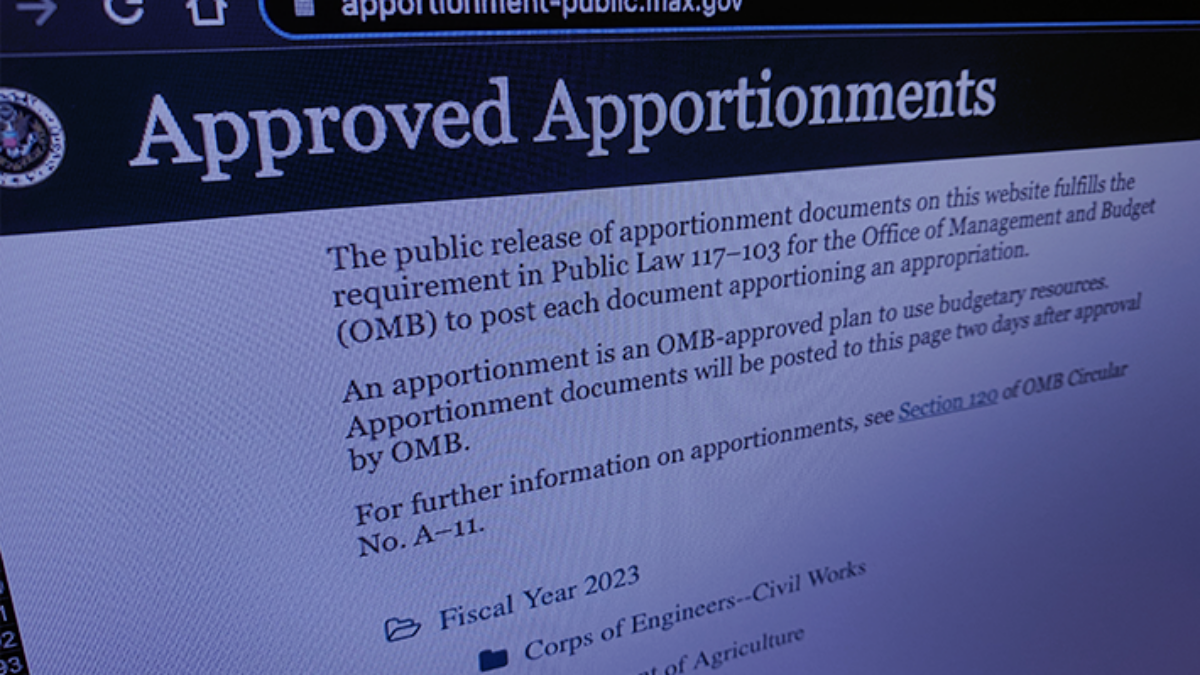In 2005, the Government Accountability Office published A Glossary of Terms Used in the Federal Budget Process. Please consult the Glossary for a comprehensive list of key terms and definitions in budget and appropriations law. A handful of terms and definitions relevant to apportionments are highlighted below. These definitions are taken from the Glossary, OMB Circular No. A-11, the Treasury Department’s FAST Book, and the Oct. 13 apportionment training. Each entry is hyperlinked to the source providing the definition.
Antideficiency Act – the federal law that:
- prohibits the making of expenditures or the incurring of obligations in advance of an appropriation;
- prohibits the incurring of obligations or the making of expenditures in excess of amounts available in appropriation or fund accounts unless specifically authorized by law (31 U.S.C. § 1341(a));
- requires the Office of Management and Budget (OMB), via delegation from the President, to apportion appropriated funds and other budgetary resources for all executive branch agencies (31 U.S.C. § 1512);
- requires a system of administrative controls within each agency (see 31 U.S.C. § 1514 for the administrative divisions established);
- prohibits incurring any obligation or making any expenditure in excess of an apportionment or reapportionment or in excess of other subdivisions established pursuant to sections 1513 and 1514 of title 31 of the United States Code (31 U.S.C. § 1517); and
- specifies penalties for deficiencies.
Apportionment – a legally binding plan approved by OMB that makes budgetary resources available to a federal agency. Apportionments set limits—beyond those in appropriations and authorization legislation—on how and when an agency may spend funds, what an agency may spend funds on, and any conditions an agency must meet before spending funds.
- Reapportionment – a revision of a previous apportionment of budgetary resources for an appropriation or fund account. OMB reapportions just as it apportions. Agencies usually submit requests for reapportionment to OMB as soon as a change becomes necessary due to changes in amounts available, program requirements, or cost factors.
Appropriation – a provision of law authorizing the expenditure of funds for a given purpose.
Appropriation Account – The basic unit of an appropriation generally reflecting each unnumbered paragraph in an appropriation act.
A-11 (OMB Circular No. A-11) – the OMB manual that offers detailed guidance to federal agencies on budget preparation, submission, and execution.
Budgetary Resources – amounts available to enter into new obligations and liquidate them. Budgetary resources are made up of unobligated balances provided in previous years and new budget authority.
New Budget Authority – New budget authority is made up of:
- Appropriations
- Borrowing authority – a type of budget authority that permits obligations and outlays to be financed by borrowing.
- Contract authority – a type of budget authority that permits you to incur obligations in advance of an appropriation, offsetting collections, or receipts to make outlays to liquidate the obligations.
- Spending authority from offsetting collections – collections authorized by law to be credited to appropriation or fund expenditure accounts.
Deferral of Budget Authority – temporary withholding or delaying of the obligation or expenditure of budget authority or any other type of executive action, which effectively precludes the obligation or expenditure of budget authority. A deferral is one type of impoundment. Under the Impoundment Control Act of 1974 (2 U.S.C. § 684), budget authority may only be deferred to provide for contingencies, to achieve savings or greater efficiency in the operations of the government, or as otherwise specifically provided by law. Budget authority may not be deferred for policy or any other reason.
The Federal Account Symbols and Titles (FAST) Book – the Treasury Department manual listing appropriation and other fund account symbols and titles. Identifying the Treasury Appropriation Fund Symbol (or TAFS)—a numerical identifier—associated with an appropriation account is the first step in the process of finding the corresponding apportionment. On OMB’s apportionment website, the TAFS is an essential component of the file name identifying an apportionment.
Obligation – a definite commitment that creates a legal liability of the government for the payment of goods and services ordered or received, or a legal duty on the part of the United States that could mature into a legal liability by virtue of actions on the part of the other party beyond the control of the United States. Payment may be made immediately or in the future. An agency incurs an obligation, for example, when it places an order, signs a contract, awards a grant, purchases a service, or takes other actions that require the government to make payments to the public or from one government account to another.
Outlay – the issuance of checks, disbursement of cash, or electronic transfer of funds made to liquidate a federal obligation. Outlays also occur when interest on the Treasury debt held by the public accrues and when the government issues bonds, notes, debentures, monetary credits, or other cash-equivalent instruments in order to liquidate obligations.
Reprogramming – shifting funds within an appropriation or fund account to use them for purposes other than those contemplated at the time of appropriation; it is the shifting of funds from one object class to another within an appropriation or from one program activity to another. While a transfer of funds involves shifting funds from one account to another, reprogramming involves shifting funds within an account.
Rescission – Legislation enacted by Congress that cancels the availability of budget authority previously enacted before the authority would otherwise expire. The Impoundment Control Act of 1974 (2 U.S.C. § 683) provides for the President to propose rescissions whenever the President determines that all or part of any budget authority will not be needed to carry out the full objectives or scope of programs for which the authority was provided. Rescissions of budget authority may be proposed for fiscal policy or other reasons. All funds proposed for rescission must be reported to Congress in a special message.
SF (Standard Form) 132 – the standard apportionment form.
SF133 – the report on budget execution and budgetary resources. SF133 reports can be accessed here.
Treasury Appropriation Fund Symbol (TAFS) – the numerical identifier associated with an appropriation account. A TAFS has three elements: a three-digit federal agency ID, a four-digit appropriation account ID, and an availability code. An availability code specifies whether the appropriation is available for one year, multiple years, or has no time limit, known as a “no-year” account.
- For example, the TAFS for the Health Care Systems appropriation account is 075 0357. “075” identifies the agency—in this case, the Department of Health and Human Services. “0357” identifies Health Care Systems as an account in the Health Resources and Services Administration.
- On OMB’s apportionment website, one sees several entries for account 0357 (the availability code is bolded):
- An annual account (075-2022-2022-0357)
- A multi-year account (075-2020-2022-0357)
- A no-year account (075-X-0357)




